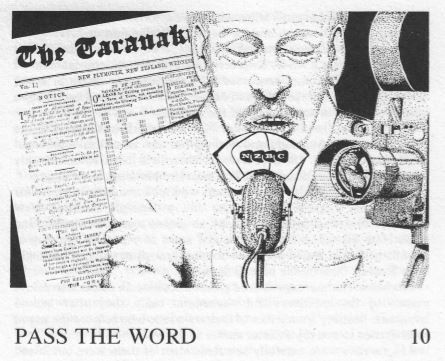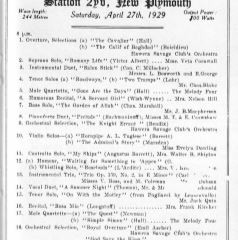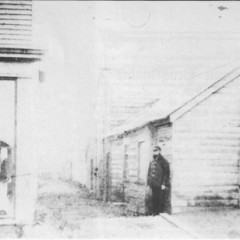10
Once the first European arrivals in New Plymouth had settled down to their new, austere way of life, one of their greatest needs was for news from 'home'-which many of them knew they would never see again. As each ship arrived, among the first cargo to be unloaded was a box of letters and newspapers, usually in the care of the ship's master (for which he received a gratuity of 4c a letter) which in many cases had been written six months before. Answers would take as long to reach England.
A postal service of sorts had been established in New Zealand in 1831 when the Postmaster-General of New South Wales deputed a Bay of Islands merchant, William Powditch, 'to receive and return mails' mainly ofa business nature. In 1840 William C. Hayes was appointed by Governor Hobson as New Zealand's first 'postmaster' handling mail at Kororareka, then the country's most important trading centre. He lasted less than six months in the job, being dismissed for dishonesty and drunkenness! and S. Grimstone was appointed in his place at a salary of '20 per cent of postal receipts in the office under his immediate control. The Royal Charter establishing New Zealand as a Crown Colony in 1841 was followed by an ordinance specifying that control of any postal service in New Zealand would be the responsibility of the British Postmaster-General, but this did little to speed deliveries, which relied on irregular sailings of ships to and from Australia and England. The need for communication within New Zealand was even more pressing, and although a service between Wellington and Wanganui (then named Petre) was established in 1841, New Plymouth had to wait until September 15, 1843, to receive its first official consignment of internal mail. This was processed in a rough raupo whare in lower Brougham Street on the slopes of Mount ElIot, which had been built a year previously in anticipation of the service. In August of the following year New Plymouth was linked to the service between Auckland and Wellington, and an official announcement on August 5, 1844, revealed: 'There will be a twice-monthly service, leaving Auckland on the first and third Mondays in the month.'3 Mails were carried by Maori runners who took about three weeks for the northern journey via Kawhia; and a fortnight between New Plymouth and Wellington. It was by no means a regular service, and often New Plymouth settlers received news of events in the Bay of Islands and even Auckland much sooner through newspapers brought from Sydney than by the official mail. The Maori runners experienced great difficulties. In addition to delays caused by flooded rivers and washed-out trails, they often had to overcome hostility from tribes of their own race who refused the use of river-ferries to convey Pakeha mail. The carriers were carefully selected. Most of them were confessed Christians, and their refusal to transport mail on Sunday, a rest day, contributed to delays. But they were responsible messengers. The Rev. John Whiteley, the honorary postmaster at Kawhia, reported in August, 1852, on the devotion to duty of a Maori postman 'in saving the mail, although losing his clothes and almost his life in crossing at the heads' when his small canoe overturned. Whiteley was authorised to replace the clothes, to reward the postman with $2 and to hire a boat for the postman to use during rough weather." The service was expensive. The Post Office Ordinance of 1842 had set the inland letter rate at 10c for half an ounce but allowed newspapers to be sent free. The British Government overruled this and reduced the rate to 8c imposing a 2c charge for newspapers. (This was further reduced in 1857 to 6c.) In 1901 Sir Joseph Ward introduced 'universal penny postage' which allowed for a rate of lc for each half-ounce on both inland letters and letters to the Colonies. This lasted until 1915 when Ward announced that all Post Office charges were to be increased and' added to the casualties of war'. This' casualty rate' for letters has increased ever since. By 1980 the minimum internal letter rate was 20c. Inland delivery problems escalated and in 1845 during a period of economic downturn, together with increasing Maori hostility, inland mails between Wellington and Auckland were discontinued.
When no ships were available official despatches and 'privileged' letters were carried by the constabulary under control of Donald McLean, Protector of the Aborigines. Following an inspection of New Zealand postal services by two London General Post Office officials, Edward James and Richard Smith, postal control was transferred from London to Governor Grey's administration in 1848. The officials travelled widely and their report was detailed: James Webster (1843-49) was referred to as postmaster and sub-collector of Customs at New Plymouth, 'conducting post office business in his house apparently satisfactorily.' In 1851 William Leech was appointed, and a 'Return by William Young, Deputy Postmaster-General of the Post Offices of New Ulster' stated that Leech's salary from his postal duties was 'nil'. His income was apparently derived from his customs duties. Problems were not confined to deliveries, either in New Plymouth or elsewhere. In Wanganui, when William Lett died in 1854, aged 37 'after a few years as postmaster it was reported that he was frequently in a state of intoxication'. William Woon (father of Garland William Woon, co-founder of the Taranaki Herald) was appointed and in the same year Leech was replaced in New Plymouth by William Gray, who had been a postal officer in Aberdeen before he came to New Plymouth. He found the Customs House, in which he had to combine his postal and customs business, 'a considerable distance from the town ... a room only 12 feet square' was used for the postal side of the work and 'did not admit of seclusion so absolutely necessary'. (Gray and his son, also William, both later held the office of head of the Postal Department.) Meanwhile, the overland route was re-established, foot-carriers being replaced by horsemen. A contract of 1858 required the mail to leave Auckland and Wellington at 2 p.m. every Monday and to be delivered every Saturday at New Plymouth. No mails were to exceed a weight of 12kg. In the same year the schooner Henry (11 tonnes) was chartered as a mail boat between New Plymouth and Nelson and other southern ports, and the steamer White White Swan carried mail from Manukau Harbour to Otago and return, calling at New Plymouth once a month. With the outbreak of hostilities between Maori and Pakeha in 1860 the overland postal service again ceased, to be reopened in 1869.
During this time the settlement relied on sea-borne mails. By 1871 Cobb and Co.'s Royal Mail was running a twice-weekly coach service between Wellington and New Plymouth, which was met at the post office by expectant crowds, for there was no town delivery until F. Eliot was appointed the town's first postman. He began work on April 1, 1878. He left the Post Office in Silver Street (since closed) each day at 10 a.m. from Monday to Saturday with central town deliveries. The opening of the railway in 1885 resulted in a great improvement of the service when, on March 23, the New Plymouth Railway Travelling Post Office was established. Business was conducted in a comparatively primitive coach without heat and lit by gas.Sorting the mail under such conditions, coupled with the upsetting movement of the train, was not an easy task. But it proved a popular innovation; two years later parcel- post was established and the service continued, with constant improve- ments, until December 31, 1931, when the PTPO was withdrawn. Official airmail was introduced in January, 1935, following more than 20 years of private trial-and-error attempts. By July, 1937, there was a regular Auckland-Wellington connection via Palmerston North and New Plymouth. World War Two hindered progress, but with peace came a great upsurge in airmail use. By 1980 senders could be assured of same-day delivery of mail to almost any centre in the country. New Plymouth opened its first telegraph station on July 10, 1871, and in April, 1872, the telegraph line from the town to a point just south of Okato was completed. Between Okato and Opunake, because of continuing unsettled conditions between Maori and Pakeha, there was a gap, and the Commissioner of Telegraphs , Sir Julius Vogel, announced: 'In order to render communications between the Stoney River and Opunake as soon as possible, a telegraph-mails service will be established leaving each place at noon daily (except Sundays) and arriving at 4 p.m. Telegrams and mails were carried on horseback, and this service remained in operation for four years until the telegraph line between Hawera and New Plymouth was erected. A telephone service came officially to the town on December 1, 1885, when there were 100 subscribers. However, there had been at least one 'telephone' in existence for almost eight years. The Taranaki Herald reported in 1878 that' Mr Day, of the White Hart Hotel, spoke to Mr Cottier, of the Masonic Hotel, by means of a 700-foot length of string stretched between two round mustard tins, the bottoms of which had been replaced with parchment.' In the first year of telephonic service revenue from the 100 subscribers amounted to $1061. Continuous service replaced the original 8 a.m. to 8 p.m. hours in 1911 and on March 7, 1950, the first automatic exchange was opened. Great development came in the 1950s with the decision to lay an underground multi-channel coaxial cable link between Auckland and Wellington. Because of the difficult terrain in the section between Palmerston North and Hamilton, a system of microwave aerials were used. New Plymouth's microwave station was built on a hill (Moun- garua, Windy Point) at Blagdon, in 1960 and is a feature of the town's south-western skyline. Its parabolic reflector picks up signals from its nearest 'sister' at Urenui. In the mid-60s a start was made with dismantling the unsightly overhead telephone lines and poles, replacing them with multi-channel underground cables. By 1980 most of the central city area had been 'opened up', and all new subdivisions provided with this method of reticulation. The New Plymouth Post Office headquarters on the corner of Currie and Gill Streets is an imposing structure, but the city had to wait 117 years to get it.
The first office in Lower Brougham Street was used for two years before a move was made to premises in Currie Street which were shared with the Customs Department. Subsequently the Post Office occupied W. Grey's store in Devon Street, John Gilmour's shop in Upper Brougham Street, and a small building on the flat near the forecourt of the present library. In 1873 the headquarters were moved to another much-too-small building on the corner of Devon and Robe Streets. When the 'old' post office and its tower were built the small building was moved to Silver Street (since closed). The present post office complex was opened by the Postmaster-General, T. P. Shand, on May 14, 1959. This was the culmination of more than 25 years of controversy, petitions and frustrating delays. It began in 1935 when the site was acquired. This immediately resulted in a petition by townspeople praying that building be not proceeded with because it was off the tram route, it was too close to the railway and the gasworks, and it would cause traffic congestion unless streets were widened at prohibitive cost. The site was favoured by the Chamber of Commerce and the Retailers' Association because it was close to the business centre. The Postmaster-General, F. Jones, visited the town, heard both sides of the case, and later confirmed the site and announced that building would start as soon as possible. He said plans and specifications were being drawn up by architect Rod Syme. But the depression, World War Two and its aftermath of financial restraint delayed building plans until June 30, 1954, when the Taranaki Herald reported that the Postmaster-General, W. J. Broad- foot, had advised E. P. Aderman, the MP for New Plymouth, the necessary authority had been given to proceed and tenders would be called later that year. This gave rise to another burst of agitation from a section of the townspeople. But time heals much. As the Post and Telegraph Department had other building commitments, it was nearly four years before the Currie Street building, which had been designed to accommodate all branches of the department's expanding activities, was opened. It was a gala occasion, Currie Street was closed to traffic between 2. p.m. and 5 p.m. because the ceremony was to be held in the open, where seating for 200 had been arranged. The crowd of several thousand heard the Postmaster-General outline some of the problems associated with the building, among them one which, at that time, had not been overcome-water seepage in the basement. A stagnant lake had been partly filled in to accommodate the building,



